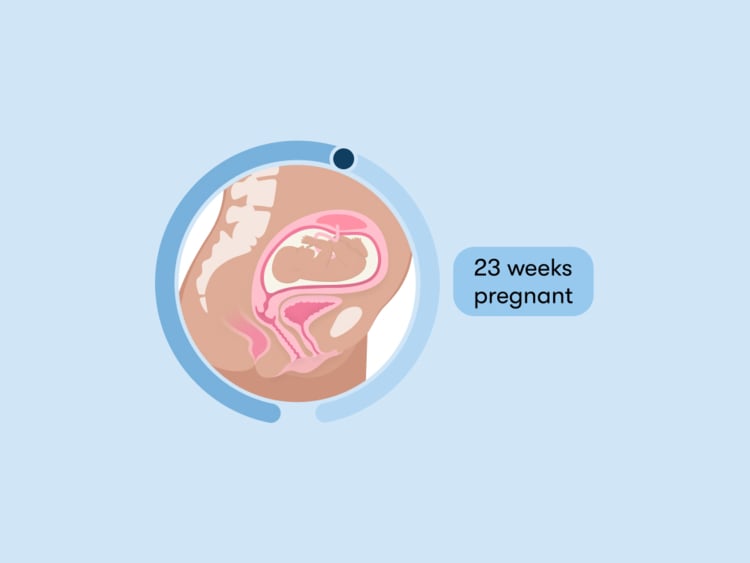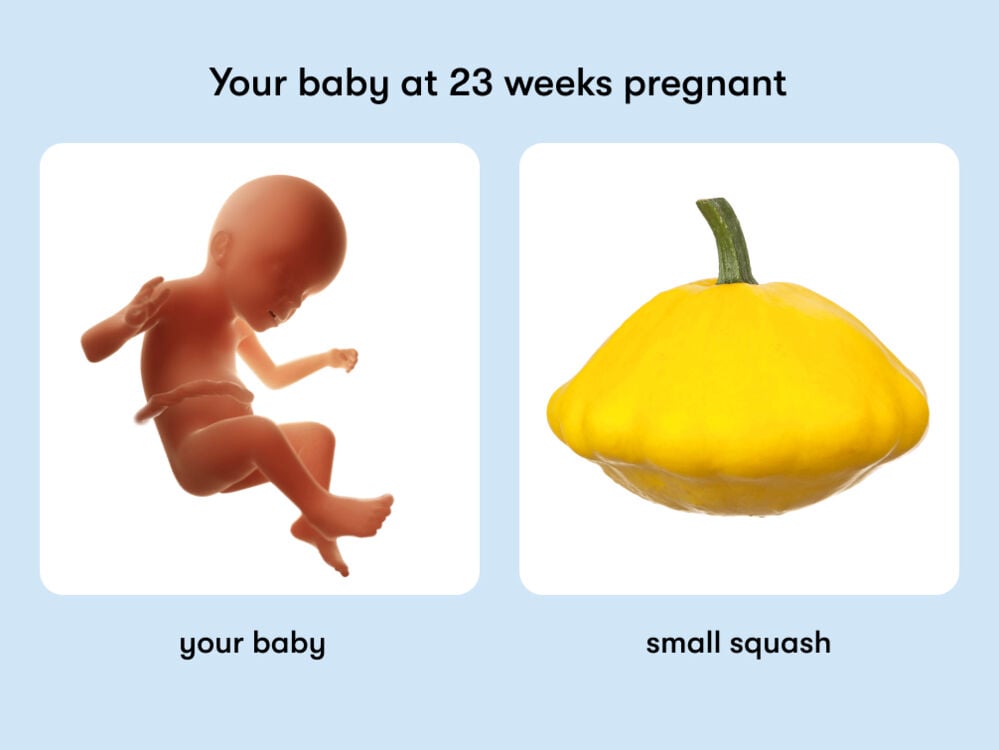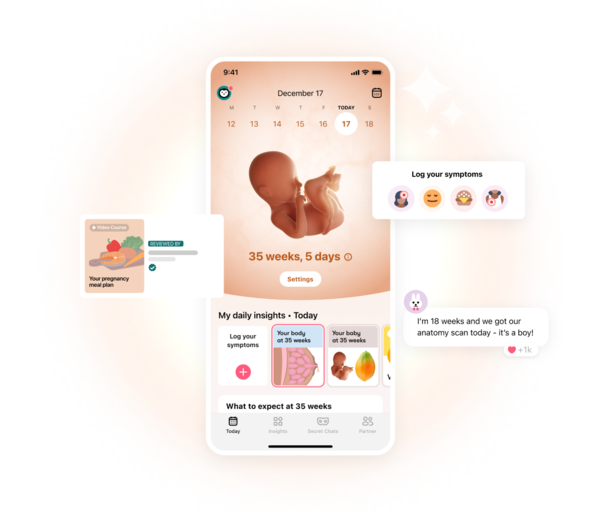From breast leaks to adjusting your sleeping position, here’s the lowdown on being 23 weeks pregnant.
-
Tracking cycle
-
Getting pregnant
-
Pregnancy
-
Help Center
-
Flo for Partners
-
Anonymous Mode
-
Flo app reviews
-
Flo Premium New
-
Secret Chats New
-
Symptom Checker New
-
Your cycle
-
Health 360°
-
Getting pregnant
-
Pregnancy
-
Being a mom
-
LGBTQ+
-
Quizzes
-
Ovulation calculator
-
hCG calculator
-
Pregnancy test calculator
-
Menstrual cycle calculator
-
Period calculator
-
Implantation calculator
-
Pregnancy weeks to months calculator
-
Pregnancy due date calculator
-
IVF and FET due date calculator
-
Due date calculator by ultrasound
-
Medical Affairs
-
Science & Research
-
Pass It On Project New
-
Privacy Portal
-
Press Center
-
Flo Accuracy
-
Careers
-
Contact Us
23 weeks pregnant: Your guide to this week of your second trimester


Every piece of content at Flo Health adheres to the highest editorial standards for language, style, and medical accuracy. To learn what we do to deliver the best health and lifestyle insights to you, check out our content review principles.
At 23 weeks, you’re over the halfway mark in your pregnancy, and your baby is hitting exciting new milestones. While they are still only the size of a small squash, they’re already starting to practice breathing, and their movements will start to feel stronger and stronger.
And it’s not just your baby that’s changing; there’s a lot going on in your own body, too. Keep reading to find out more about the symptoms you can expect at 23 weeks pregnant, plus lifestyle tips for a healthy baby and mom, and advice from a Flo expert.
Your baby at 23 weeks pregnant
Practicing breathing actions
This week, your baby is practicing how to breathe, although they will continue getting all of their oxygen from you via the placenta until they’re born. By 36 weeks, their little lungs will be fully developed and ready to go.
Feeling stronger movements
You may also start to feel the sensations of your baby’s movements become stronger this week. Their kicks may even start to make your tummy move, which can be a strange, wonderful, and funny experience all at once. The movements may also feel strong enough now for other people to feel them on your belly, which can be a lovely way for them to bond with your baby.
How big is a baby at 23 weeks?
Length (crown to heel): 30.6 cm or 12.1 in.
Weight: 568 g or 1.3 lb.
Size: Equivalent to a small squash
All measurements are approximate and vary within the normal range.

Your body at 23 weeks pregnant
Breast leaks
This week, you may start to notice that your breasts are leaking a milky, yellow substance called colostrum. This might be alarming at first, but try not to worry — it’s a totally normal part of pregnancy. In fact, colostrum is packed with nutrients, antibodies, and antioxidants that will eventually help to strengthen your newborn baby’s immune system. Colostrum is the first kind of breast milk that you’ll produce, and it’ll change into regular breast milk within two to four days after giving birth. You might experience colostrum as leakage or as a dried substance on your nipples, both of which are completely normal. It’s also common not to experience colostrum at 23 weeks pregnant, so don’t worry if you haven’t noticed this symptom just yet.
While we’re on the subject, it’s also a good idea to keep checking your breasts before and after having a baby. It’s normal for hormone changes in pregnancy to cause changes to the breast tissue, which can lead to harmless lumps and bumps.
But if you are concerned about any new lumps or changes to an existing lump in your breasts, tell your doctor right away. While they will most likely be nothing to worry about, and breast cancer during pregnancy or in women of childbearing age is uncommon, it’s always worth speaking to your health care provider.
Constipation
Constipation is another pesky pregnancy symptom that can begin in the first trimester but crop up in the second trimester too. It can be very uncomfortable, so be extra kind to yourself if you’re experiencing it. Unfortunately, constipation is common in pregnancy, affecting around 16% to 39% of pregnant people. So, if it helps, remember that you’re not alone and many pregnant women get constipated — even if they don’t talk about it.
Medications like stool softeners and laxatives are generally safe to use in pregnancy and available over the counter, but always check with your doctor before taking any kind of medication while pregnant. Some simple lifestyle adjustments can also help, like eating more fiber, drinking plenty of water, and exercising regularly.
Your questions answered
Are you six months pregnant at 23 weeks?
At 23 weeks pregnant, you are indeed in your sixth month of pregnancy. It’s an amazing month for your baby, who will hit major milestones like practicing breathing movements, gaining fully formed lungs, and being able to touch their tiny little ears.
If you’re wondering how to refer to 23 weeks pregnant in months, know that talking about your pregnancy in terms of weeks can be more accurate. Important milestones in pregnancy are determined by weeks. For example, whether a pregnancy is term (from 37 weeks) or preterm (less than 37 weeks) is separated by just one week.
“We prefer not to group weeks of pregnancy into months for a few reasons,” explains Dr. Cynthia DeTata, clinical assistant professor of obstetrics and gynecology at Lucile Packard Children’s Hospital, California, US. “First, months vary in length. Second, knowing the exact week timing is very important in a number of circumstances, including for prenatal testing, stopping preterm labor if it occurs, the timing of routine tests during pregnancy, and knowing when it’s a good time to deliver.”
If you’re looking for an easy way to keep up with the weeks as they pass, you can also try tracking your pregnancy using an app like Flo.
Is the baby fully developed at 23 weeks?
Not quite yet! At 23 weeks pregnant, your baby is settling into sleeping and waking patterns (just like you!), and their limbs are now in proportion. However, they won’t be full term until 39 weeks. From around 24 weeks of pregnancy, it is possible for babies to be born prematurely and survive — however, they would need specialist care in a neonatal unit in a hospital. Try not to worry, though, as extreme preterm births (defined as babies born before 28 weeks of pregnancy) are very rare, affecting just two to five pregnancies in every 1,000.
Just so you know, deliveries are often classified in the following way:
- Extremely preterm: less than 28 weeks
- Very preterm: 28 to 31 weeks and 6 days
- Moderate to late preterm: 32 to 36 weeks and 6 days
- Early term: 37 weeks to 38 weeks and 6 days
- Full term: 39 weeks to 40 weeks and 6 days
- Late term: 41 weeks to 41 weeks and 6 days
- Postterm: 42 weeks and beyond
That’s a lot of numbers to take in, but hopefully you can use this as a reference if you need it.
When does the third trimester start?
The third trimester kicks off at 28 weeks pregnant, so you’re not that far off the final stretch. In the last stage of your pregnancy, you will likely become more uncomfortable as your baby continues to grow, but hold tight — it won’t be long before you can meet your little one. As you move into your third trimester, your doctor might also increase your regular appointments from once a month to every two weeks. The third trimester is also when many people start preparing for a baby at home and putting together a newborn essentials checklist.
Take a quiz
Find out what you can do with our Health Assistant
23 weeks pregnant checklist
Eat more carbohydrates
Good news for pasta lovers — carbohydrates are an important part of a healthy diet in pregnancy, as they help give your body energy to function. On average, it’s recommended that pregnant and breastfeeding women eat 175 g of carbs per day at the very minimum.
As you may already be aware, not all carbohydrates are created equally. Some are much healthier than others, and these might be a better option to add to your shopping cart. For example, instead of reaching for refined carbohydrates like white bread, pasta, and rice, why not go for whole grain bread or whole wheat pasta and brown rice instead?
However, other food groups are just as — if not more — important to be eating at this stage, as Dr. DeTata explains. “Most people have nausea and food aversions and often only eat plain carbohydrates until the second trimester,” she says. “I have had patients tell me they could only eat plain bagels or white rice. Twenty-three weeks may be around the time when those symptoms have abated, and it is more important to eat vegetables, fruit (in plain form, not juice), and low-fat protein. The baby is going through a rapid growth spurt and will need more than just simple carbohydrates.” If you would like more advice and inspiration for planning your pregnancy diet, you can read our handy guide to healthy eating during this time here.
Sleep on your side
Now is a great time to get into the habit of sleeping on your side if you can. This is considered to be the safest sleeping position in pregnancy, and it doesn’t matter whether you snooze on your left or right side. It’s important to note that sleeping on your back can double the risk of stillbirth after you’re 28 weeks along. However, there’s no need to panic if you do wake up on your back — you can’t control what your body does when you’re asleep, after all. But if this happens in the middle of the night, just turn to your side and try to get back to sleep. And try not to worry too much about this happening, as research shows that pregnant women sleep the longest in the position they fall asleep in, so hopefully you’ll stay in one position throughout the night.
Prepare your body for labor
While your antenatal or prenatal classes may not start until around 30 weeks, there are other ways you can start preparing your body for the different stages of labor at 23 weeks pregnant. For example, pregnancy yoga classes will teach you modified poses to accommodate your changing balance and can help to reduce stress.
It’s also important for your body to be generally fit, so try adding some exercise to your routine. Moderate-intensity workouts (when you’ve moving enough to raise your heart rate and sweat) like swimming, cycling, and walking are safe in pregnancy. If you exercised a lot before you were pregnant, it may be safe to continue with your previous workouts. Speak to your doctor to check what’s best for you and your pregnancy.
You can also help prepare your mind for labor by learning some relaxation techniques, like breathing exercises, mindfulness, or visualization. If you start practicing them now, it can help them feel like second nature when the big day arrives. If you’re already feeling anxious about giving birth, these techniques can help you feel more prepared, as well as cope with any current worries.
Feeling anxious while pregnant — sometimes called perinatal anxiety — is common, affecting one in 10 pregnant women. If you’re struggling, know that it doesn’t mean that you’re a failure or not cut out for parenthood. It’s not your fault that you’re feeling this way. Help is out there to make the feelings more bearable, from cognitive behavioral therapy (CBT) to relaxation techniques and mindfulness therapy. Your doctor can discuss the different treatment options with you and help you get the support you deserve.
When to consult a doctor at 23 weeks pregnant
You should have regular appointments with your doctor, which might be every four weeks when you’re around 23 weeks pregnant. It depends on where you live and what’s right for your pregnancy. During these visits, your doctor will check your vitals, like your blood pressure and weight, as well as track your baby’s growth and heart rate.
You don’t need to wait until your appointment if you have any concerns or questions about your pregnancy. However, at 23 weeks pregnant, you should contact your doctor immediately if you experience:
- Severe cramping
- Vaginal bleeding
- Changes in vaginal discharge
- Fever
- Dizziness or fainting
- Severe vomiting
- Severe headaches or blurry vision
- Intense heartburn
- A loss of liquid from your vagina or watery/mucus-like discharge (This could be a sign of premature labor.)
This isn’t an exhaustive list and just an example of some of the changes you should look out for. Some of these can be a sign of health complications, so it’s essential that you speak to your doctor about the best next step for you. And if you’re worried about any other symptoms you experience during pregnancy, don’t hesitate to reach out to your health care provider.
23 weeks pregnant: The takeaway
At 23 weeks pregnant, you might be experiencing common symptoms such as breast leaks and constipation — but it’s also normal not to experience any of these symptoms at all. You’re reaching the end of your second trimester, and this can be an overwhelming time, so try to take things easy as you navigate the changes happening both in your body and with your baby. You’ve got this!


Hey, I'm Anique
I started using Flo app to track my period and ovulation because we wanted to have a baby.


The Flo app helped me learn about my body and spot ovulation signs during our conception journey.


I vividly
remember the day
that we switched
Flo into
Pregnancy Mode — it was
such a special
moment.
Real stories, real results
Learn how the Flo app became an amazing cheerleader for us on our conception journey.
References
“Antenatal Classes.” NHS, www.nhs.uk/pregnancy/labour-and-birth/preparing-for-the-birth/antenatal-classes/. Accessed 5 July 2023.
“Anxiety and Panic Attacks in Pregnancy.” Tommy’s, www.tommys.org/pregnancy-information/im-pregnant/mental-wellbeing/anxiety-and-panic-attacks-pregnancy. Accessed 5 July 2023.
“Bleeding during Pregnancy.” The American College of Obstetricians and Gynecologists, May 2021, www.acog.org/womens-health/faqs/bleeding-during-pregnancy.
“Breast Care and Breast Health in Pregnancy.” NHS Betsi Cadwaladr University Health Board, bcuhb.nhs.wales/health-advice/pregnancy-early-years-and-family/breast-care-and-breast-health/. Accessed 5 July 2023.
“Carbohydrates: How Carbs Fit into a Healthy Diet.” Mayo Clinic, 22 Mar. 2022, www.mayoclinic.org/healthy-lifestyle/nutrition-and-healthy-eating/in-depth/carbohydrates/art-20045705.
“Carbohydrates.” Cleveland Clinic, my.clevelandclinic.org/health/articles/15416-carbohydrates. Accessed 5 July 2023.
Carney, Michael E. “Breast Disease: Impact of Sex Steroid Replacement.” Encyclopedia of Endocrine Diseases, Elsevier, 2004, pp. 419–23. www.sciencedirect.com/topics/immunology-and-microbiology/breast-duct.
“Colostrum.” Cleveland Clinic, my.clevelandclinic.org/health/body/22434-colostrum. Accessed 5 July 2023.
Curran, Mark A. “Fetal Development.” Perinatology, perinatology.com/Reference/Fetal%20development.htm. Accessed 5 July 2023.
“Definition of Term Pregnancy.” The American College of Obstetricians and Gynecologists, 13 Nov. 2013, www.acog.org/clinical/clinical-guidance/committee-opinion/articles/2013/11/definition-of-term-pregnancy.
“Fetal Development.” Cleveland Clinic, my.clevelandclinic.org/health/articles/7247-fetal-development-stages-of-growth. Accessed 15 June 2023.
Friel, Lara A. “Fevers during Pregnancy.” MSD Manual Consumer Version, Oct. 2021, www.msdmanuals.com/home/women-s-health-issues/pregnancy-complicated-by-disease/fevers-during-pregnancy.
“Have a Healthy Diet in Pregnancy.” NHS, www.nhs.uk/pregnancy/keeping-well/have-a-healthy-diet/. Accessed 5 July 2023.
Misri, Shaila, et al. “Perinatal Generalized Anxiety Disorder: Assessment and Treatment.” Journal of Women’s Health, vol. 24, no. 9, Sep. 2015, pp. 762–70. www.ncbi.nlm.nih.gov/pmc/articles/PMC4589308/.
Morgan, Andrei S., et al. “Management and Outcomes of Extreme Preterm Birth.” BMJ, vol. 376, Jan. 2022, p. E055924, www.bmj.com/content/376/bmj-2021-055924.
“Morning Sickness: Nausea and Vomiting of Pregnancy.” The American College of Obstetricians and Gynecologists, May 2020, www.acog.org/womens-health/faqs/morning-sickness-nausea-and-vomiting-of-pregnancy.
Langer, A., et al. “Breast Lumps in Pregnant Women.” Diagnostic and Interventional Imaging, vol. 96, no. 10, Oct. 2015, pp. 1077–87, pubmed.ncbi.nlm.nih.gov/26341843.
“Pregnancy and Exercise: Baby, Let’s Move!” Mayo Clinic, 12 Mar. 2021, www.mayoclinic.org/healthy-lifestyle/pregnancy-week-by-week/in-depth/pregnancy-and-exercise/art-20046896.
“Pregnancy And Exercise.” The American College of Obstetricians and Gynecologists, Mar. 2022, www.acog.org/womens-health/faqs/exercise-during-pregnancy.
“Pregnancy and Heartburn.” Cleveland Clinic, my.clevelandclinic.org/health/diseases/12011-heartburn-during-pregnancy. Accessed 14 June 2023.
“Pregnancy Constipation: Are Stool Softeners Safe?” Mayo Clinic, 28 May 2022, www.mayoclinic.org/healthy-lifestyle/pregnancy-week-by-week/expert-answers/pregnancy-constipation/faq-20058550.
“Pregnancy Constipation.” Cleveland Clinic, my.clevelandclinic.org/health/diseases/21895-pregnancy-constipation. Accessed 5 July 2023.
“Premature Labour and Birth.” NHS, www.nhs.uk/pregnancy/labour-and-birth/signs-of-labour/premature-labour-and-birth/. Accessed 5 July 2023.
“Prenatal Care: 2nd Trimester Visits.” Mayo Clinic, 4 Aug. 2022, www.mayoclinic.org/healthy-lifestyle/pregnancy-week-by-week/in-depth/prenatal-care/art-20044581.
“Preterm Birth.” World Health Organization, www.who.int/news-room/fact-sheets/detail/preterm-birth. Accessed 5 July 2023.
“Preterm Labor.” Mayo Clinic, 8 Feb. 2022, www.mayoclinic.org/diseases-conditions/preterm-labor/symptoms-causes/syc-20376842.
Smith, Caroline A., et al. “Relaxation Techniques for Pain Management in Labour.” Cochrane Database of Systematic Reviews, vol. 3, no. 3, Mar. 2018, p. CD009514, www.ncbi.nlm.nih.gov/pmc/articles/PMC6494625/.
“Special Tests for Monitoring Fetal Well-Being.” The American College of Obstetricians and Gynecologists, May 2019, www.acog.org/womens-health/faqs/special-tests-for-monitoring-fetal-well-being.
Sweeting, Arianne, et al. “The Carbohydrate Threshold in Pregnancy and Gestational Diabetes: How Low Can We Go?” Nutrients, vol. 13, no. 8, July 2021, https://doi.org/10.3390/nu13082599.
“The Third Trimester.” Johns Hopkins Medicine, 8 Aug. 2021, www.hopkinsmedicine.org/health/wellness-and-prevention/the-third-trimester.
“Tiredness and Sleep Problems.” NHS, www.nhs.uk/pregnancy/related-conditions/common-symptoms/tiredness/. Accessed 26 June 2023.
“Treating Constipation during Pregnancy.” Cleveland Clinic, my.clevelandclinic.org/health/diseases/21895-pregnancy-constipation. Accessed 5 July 2023.
“Urgent Maternal Warning Signs.” Centers for Disease Control and Prevention, 27 Feb. 2023, www.cdc.gov/hearher/maternal-warning-signs/index.html.
“Vaginal Discharge in Pregnancy.” NHS, www.nhs.uk/pregnancy/related-conditions/common-symptoms/vaginal-discharge/. Accessed 14 June 2023.
“When Can Others Feel Baby Move?” New Kids Center, www.newkidscenter.org/When-Can-Others-Feel-Baby-Move.html. Accessed 5 July 2023.
“You and Your Baby at 23 Weeks Pregnant.” NHS, www.nhs.uk/pregnancy/week-by-week/13-to-27/23-weeks/. Accessed 5 July 2023.
“You and Your Baby at 36 Weeks Pregnant.” NHS, www.nhs.uk/pregnancy/week-by-week/28-to-40-plus/36-weeks/. Accessed 5 July 2023.
“5 Positive Ways to Prepare for Labour.” Tommy’s, www.tommys.org/pregnancy-information/giving-birth/5-positive-ways-prepare-labour. Accessed 5 July 2023.
“23 Weeks Pregnant.” NHS, www.nhs.uk/start-for-life/pregnancy/week-by-week-guide-to-pregnancy/2nd-trimester/week-23/. Accessed 5 July 2023.
“28 Weeks Pregnant.” NHS, www.nhs.uk/start4life/pregnancy/week-by-week/3rd-trimester/week-28/. Accessed 5 July 2023.
History of updates
Current version (01 August 2023)
Published (24 February 2019)
In this article

Get your personal guide to pregnancy with the Flo app
-
Follow your baby's growth week by week
-
Get expert info on symptoms, safe foods, and more
-
Chat with other parents-to-be




